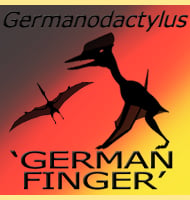In Depth
Saniwa is one of the better known genera of prehistoric monitor lizard, and although initially only known from North America, specimens are now known from Europe as well as northern Asia. Like monitor lizards living today, Saniwa was a predator. Juvenile monitor lizards tend to focus upon hunting invertebrates like insects, but as they grow bigger and reach sizes like those Saniwa is known to have attained they switch to a more vertebrate exclusive diet and hunt everything from other lizards to mammals and birds.
Saniwa was not quite a modern monitor lizard, though it was certainly close. The jugal (cheekbone) of Saniwa still projected slightly forwards in front of the eye and the suture between the frontal and parietal bones is straight. Additionally, Saniwa still has teeth growing from the palate. Apart from these Saniwa still resembled a modern monitor lizard by scurrying around on all fours. Lizards of the Saniwa genus are also noted for having a tail proportionately much longer than that of the body; as much as almost two thirds of the total body length was tail.
Unlike many fossil genera, the appearance of Saniwa is beyond doubt thanks to some very well preserved specimens. The best of these is a juvenile from the Green River Formation of Wyoming which was found not only complete and fully articulated, but also with some of the internal soft tissues and scales as well.
Saniwa was also the first extinct lizard to be named from North America.
Further Reading
- Descriptions of Emys jaenesi, E. haydeni, Baena arenosa, and Saniwa ensidens, Joseph Leidy - 1870. - The anatomy of the fossil varanid lizard Saniwa ensidens Leidy, 1870, based on a newly discovered complete skeleton, O. Rieppel & L. Grande - 2007. - Re-assessment of varanid evolution based on new data from Saniwa ensidens Leidy, 1870 (Squamata, Reptilia), J. Conrad, O. Rieppel & L. Grande - 2008. - Holotype snout elements of Saniwa ensidens reassigned to cf. Restes sp. indet. (Xenosauridae), M. W. Caldwell - 2003.- The Only Known Jawed Vertebrate with Four Eyes and the Bauplan of the Pineal Complex. – Current Biology. 28 (7): 1101–1107. – Krister T. Smith, Bhart-Anjan S. Bhullar, Gunther K�hler & J�rg Habersetzer – 2018.









